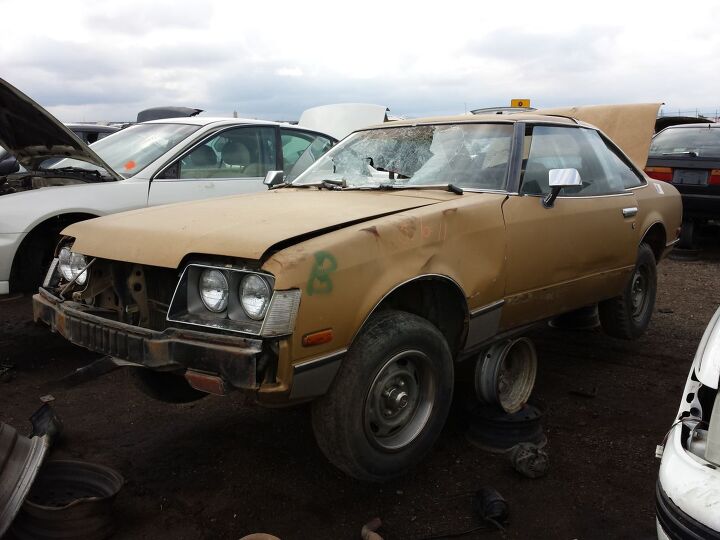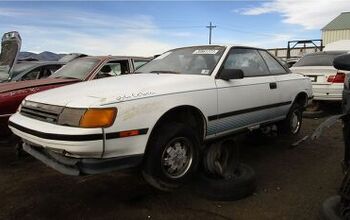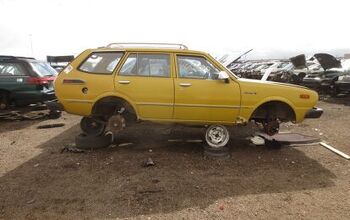Junkyard Find: 1978 Toyota Celica GT

The first- and second-generation Toyota Celica was to my generation of freshly-minted California drivers (I got my license in 1982) what the early Ford Mustang was to those born a decade earlier: fairly inexpensive and sensible, but still sporty enough to make you feel cool. I drove a ’69 Corona four-door, possibly the uncoolest car a teenager could own at the time, which was to the Celica in 1982 as the six-cylinder Fairlane sedan was to the Mustang in 1972. These days, of course, all the rear-wheel-drive Celicas are considered worth having… unless they’re in rough condition, in which case they are worth little more than scrap value. Here’s an unrusty-but-still-battered ’78, done up in painfully-late-70s Crisis of Confidence Mustard Yellow, sitting in a Denver self-serve yard.
The very sturdy 2.2-liter 20R engine made good torque, as befitted an engine well-suited for hauling Hilux-driving, Soviet-fighting mujahideen over mountain passes. You couldn’t spin the R much, as many LeMons racers have discovered, but it would outlast the rest of a Celica.
When did the 5-speed become commonplace enough that it wasn’t worth bragging about via badging?
Speaking of badging, can someone explain what these “CARPET” decals on the rear quarter windows mean?
The interior is pretty beat, but you can still make out the nothing-like-a-Corolla sportiness here.
Guys with huge Malaise mustaches and earthtone suits knew: ditch the Volaré, get a Celica!
A car that gives you your money’s worth.

Murilee Martin is the pen name of Phil Greden, a writer who has lived in Minnesota, California, Georgia and (now) Colorado. He has toiled at copywriting, technical writing, junkmail writing, fiction writing and now automotive writing. He has owned many terrible vehicles and some good ones. He spends a great deal of time in self-service junkyards. These days, he writes for publications including Autoweek, Autoblog, Hagerty, The Truth About Cars and Capital One.
More by Murilee Martin
Latest Car Reviews
Read moreLatest Product Reviews
Read moreRecent Comments
- Groza George I don’t care about GM’s anything. They have not had anything of interest or of reasonable quality in a generation and now solely stay on business to provide UAW retirement while they slowly move production to Mexico.
- Arthur Dailey We have a lease coming due in October and no intention of buying the vehicle when the lease is up.Trying to decide on a replacement vehicle our preferences are the Maverick, Subaru Forester and Mazda CX-5 or CX-30.Unfortunately both the Maverick and Subaru are thin on the ground. Would prefer a Maverick with the hybrid, but the wife has 2 'must haves' those being heated seats and blind spot monitoring. That requires a factory order on the Maverick bringing Canadian price in the mid $40k range, and a delivery time of TBD. For the Subaru it looks like we would have to go up 2 trim levels to get those and that also puts it into the mid $40k range.Therefore are contemplating take another 2 or 3 year lease. Hoping that vehicle supply and prices stabilize and purchasing a hybrid or electric when that lease expires. By then we will both be retired, so that vehicle could be a 'forever car'. Any recommendations would be welcomed.
- Eric Wait! They're moving? Mexico??!!
- GrumpyOldMan All modern road vehicles have tachometers in RPM X 1000. I've often wondered if that is a nanny-state regulation to prevent drivers from confusing it with the speedometer. If so, the Ford retro gauges would appear to be illegal.
- Theflyersfan Matthew...read my mind. Those old Probe digital gauges were the best 80s digital gauges out there! (Maybe the first C4 Corvettes would match it...and then the strange Subaru XT ones - OK, the 80s had some interesting digital clusters!) I understand the "why simulate real gauges instead of installing real ones?" argument and it makes sense. On the other hand, with the total onslaught of driver's aid and information now, these screens make sense as all of that info isn't crammed into a small digital cluster between the speedo and tach. If only automakers found a way to get over the fallen over Monolith stuck on the dash design motif. Ultra low effort there guys. And I would have loved to have seen a retro-Mustang, especially Fox body, have an engine that could rev out to 8,000 rpms! You'd likely be picking out metal fragments from pretty much everywhere all weekend long.
















































Comments
Join the conversation
They mean (1970s) "Hey! My Toyota's got carpets! Woo!"
I'm intrested in a1980 toyota pickup
I need all the vsv valves and hoses.. CA